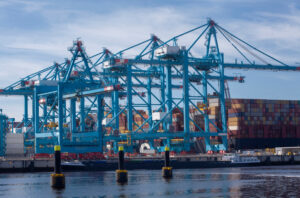Welcome to PTI’s year in review for 2022.
As we have worked through the months away from the COVID-19 pandemic, despite continued aftershocks which threatened to limit the supply chain, BCOs have largely had a smoother experience in moving cargo compared to the two years prior.
But 2022 had its own logistics hiccups: strikes rampaged through major European ports of Liverpool, Felixstowe, Hamburg & Bremerhaven; and ports shut due to brutal weather phenomena in North America and East Asia.
Despite some of the doom and gloom, there has been a bunch of great news in our industry for 2022!
Looking at some general major development in ports and shipping from the past 12 months:
- Ever Alot breaks record for world’s largest containership
- MSC to receive world’s largest containership
- CMA CGM to buy New York, New Jersey terminals
- TiL, Ports America sign on to $1.8 billion Louisiana Port Expansion Project
- German government approves COSCO investment in CTT deal
Digitalisation
Ports across the industry are considering a major mix of emerging technologies for their operations.
Internet of Things, Artificial Intelligence and Machine Learning, Digital Twin technologies, 5G and soon 6G, autonomous operations, as well as the growth of quantum computing are just a handful of solutions in which ports have invested in for 2022.
One of the key discussion points in the industry currently is on the sharing of data. Earlier this year, in a bid to take a more accurate gauge of the supply chain, the U.S. Transportation Department (USDOT) began sharing data with partners of its Freight Logistics Optimization Works (FLOW) programme.
Container ports and their equipment fleets are becoming smarter and increasingly digitised. Earlier this year Hapag-Lloyd announced the installation of live trackers on all of its containers to which customers will be to benefit from early 2023. The carrier’s entire box fleet will be trackable by the end of 2023.
As such, greater amounts of information are being collected, offering up major opportunities for ports to share data on container flows, peak box congestion times, and emissions output for faster, smarter and greener operations.
More broadly, a great deal of work is being done on standardisation. As ports are becoming connected, standardisation ensures that two sets of machines can ‘talk’ to each other through standardised language to ensure better communication through the supply chain. Read our October technical paper from Henning Schleyerbach, COO of Digital Container Shipping Association (DCSA), for more work in that field.
Finally on digitalisation, with increased connectivity through technology, opens up the door for cyber-attacks on port infrastructure. In February a ransomware attack caused a full system outage at one of the container terminals at Jawaharlal Nehru Port Trust (JNPT).
Sustainability
Now, we would like to direct your attention to the work of the ports sector on sustainability.
The International Maritime Organization has set targets for the shipping sector to reduce its Carbon Dioxide levels by at least 70 per cent compared to 2008 levels by 2050. With that target, it is imperative for ports to play a role in reducing emissions both on the land side and marine operations.
Electrification, for example, has become a prominent weapon in a port’s arsenal to reduce emissions for a container terminal:
- Ports of Los Angeles/Long Beach welcome first Nikola battery-electric trucks
- Port of Prince Rupert activates shore power to box terminal
- Port of Long Beach trials zero-emissions electric cranes
Away from electrification, 2022 has been an interesting year for renewable fuels.
We have seen investment in a plethora of green fuels from industry players. The major emerging green fuels for shipping we are seeing are green hydrogen, ammonia, methanol, and biofuels, to move away from CO2-emitting vessels and port operations.
2023 outlook
Ports are seeing a relative dip in congestion outside of their terminals compared to the past two years.
Schedule reliability continues to climb, and the drop in import demand and clearing backlog means that hopefully in 2023, we will see a reduction in waiting times for vessels, trucks, trains, or barges.
Currently, we would argue that workforce disputes are of grave concern to the shipping community when it comes to ensuring the supply chain is kept operating.
The threat of strike action, geopolitical pressures, and another Black Swan event such as the Suez Canal incident highlights that supply chains can still be severely impacted.
PTI wishes you a pleasant Holiday break and looks forward to seeing you again in 2023!













